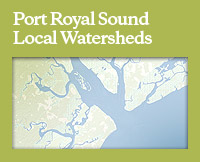Fisheries Research is Critical to Port Royal Sound
 Friday, November 11, 2011 at 5:29PM
Friday, November 11, 2011 at 5:29PM Until about 12 years ago, the Port Royal Sound Estuarine system and Beaufort County fisheries research was generally ignored by state marine biologists, largely because the political influence and funding priorities were being directed more toward the Charleston, Georgetown and Myrtle Beach areas. Because all saltwater fisheries are managed on a statewide or regional basis, whenever any particular species became stressed or overfished anywhere we were all subject to the same regulations regardless of the excellent condition of our local fish stocks. When SCDNR was able to direct more resources to the Port Royal Sound system, it was already becoming obvious that we had the most fertile, pristine and important marine ecosystem on the South Carolina coast and perhaps in the Southeast. In order to protect our fisheries from the increasing pressure of our coastal population boom we need to play catch up on research in order to give our natural resource agencies the right tools to manage them.
Our Cobia fishery had been the most neglected. Even though it had become our second leading fishery in popularity and revenue to the local economy, 85% of the Cobia caught in the state were from Beaufort County waters and at our nearby artificial reefs. Therefore it was not a priority for the rest of the state or SCDNR. In 2001, that all changed with an intense series of research projects using satellite tagging, DNA collection and analysis, and the development of a very successful stock enhancement program at the Waddell Mariculture Center. Relying on the continued collection of DNA samples, SCDNR is rapidly developing a very good picture of the health and needs of our local Cobia fishery.
The Red Drum fishery, our number one in popularity and revenue has had continuous support in both research and stock enhancement by SCDNR but it has been largely concentrated on the juvenile and sub-adult fish that reside in our inshore estuaries. The critical research that is needed is on the adult brood stock population that spends most of its time in our offshore waters. Funded by the Port Royal Sound Foundation and supported by SCDNR and our local charter captains, marine biologist Glenn Ulrich will be conducting a multi year study, collecting DNA, installing conventional and microchip tags, taking measurements, analyzing population characteristics and determining the Red Drum spawning grounds.
The most significant research conclusion so far is that the adult Cobia and Red Drum fish stocks are indigenous. They do not migrate elsewhere but rather move in and out of our Port Royal Sound system as the water temperature changes and spawning needs are met. Thus the health of both of these fisheries is strongly dependent on our local stewardship and protection of their estuarine water quality, food chain and nursery habitat.



